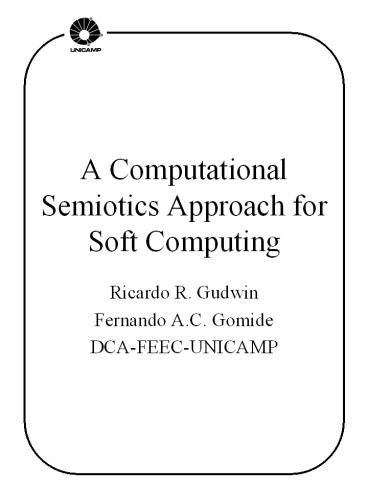A Computational Semiotics Approach for Soft Computing - PowerPoint PPT Presentation
1 / 5
Title:
A Computational Semiotics Approach for Soft Computing
Description:
A Computational Semiotics Approach for Soft Computing Ricardo R. Gudwin Fernando A.C. Gomide DCA-FEEC-UNICAMP Introduction Computational Intelligence and Soft ... – PowerPoint PPT presentation
Number of Views:94
Avg rating:3.0/5.0
Title: A Computational Semiotics Approach for Soft Computing
1
A Computational Semiotics Approach for Soft
Computing
- Ricardo R. Gudwin
- Fernando A.C. Gomide
- DCA-FEEC-UNICAMP
2
Introduction
- Computational Intelligence and Soft Computing
- model intelligent behavior using ideas from
biology and the definition and use of uncertainty - fuzzy systems
- neural networks
- evolutive systems
- Hybrid Models
- neuro-fuzzy
- neuro-genetic
- fuzzy-genetic
3
Introduction
- Computational Semiotics
- Emulation of the process of Semiosis in a
computer system - Mathematically define concepts from semiotics in
order to be used in a computer system - Object (agent)-oriented structure
- Meta-theoretical tool designed to formalize
intelligent systems - Unify the representations used to formalize the
different behaviors found within soft computing
4
Fundamental Transformations
- Argumentative knowledge
- arguments
- knowledge of transforming knowledge
- Three main arguments
- knowledge extraction (deduction)
- knowledge generation (induction)
- knowledge selection (abduction)
- Selection and Internal Functions in an active
object - Building blocks for intelligent systems (soft
computing)
5
Conclusions
- Computational Semiotics
- aiming at an unified formal model for soft
computing - extending soft computing through hybrid systems
- focus on the knowledge process embedded in each
soft computing technique (fuzzy, neural, genetic) - Use of deductive, inductive and abductive
arguments to build intelligent behavior - Formal model easily converted into a
computational algorithm - General enough to accommodate specific details of
each soft computing technique - Do not compete with the current developments for
each technique































